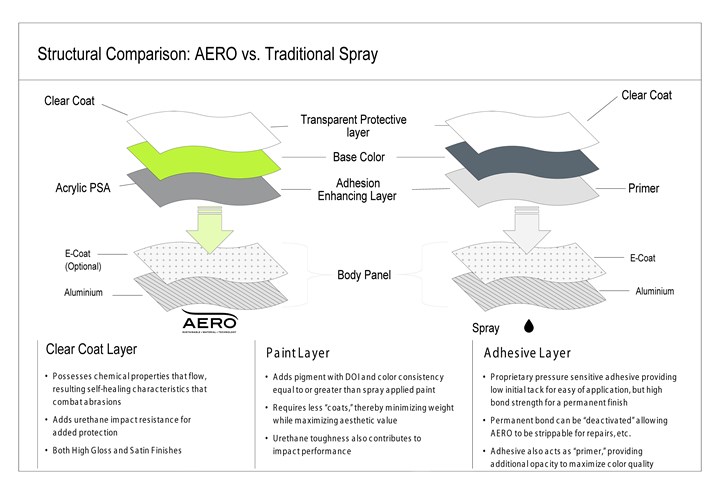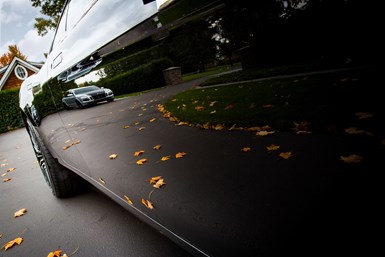
In addition to excellent aesthetics comparable to spray paint and far greater damage resistance than paint, advanced paint films from Aero Sustainable Material Technology have self-healing properties when subjected to minor abrasion, helping provide long-term durability and weatherability. The technology is commercial on several models from Jaguar Land Rover Automotive PLC.
Photo Credit: All images Aero Sustainable Material Technology, Inc.
Paint — especially solvent-based types — is a growing concern in many industries owing to the high cost of operating paint lines and complying with environmental requirements. Still, it’s the finishing technology against which most decorative alternatives are compared.
A decorative film technology from Aero Sustainable Material Technology, Inc. of Columbus, Ohio, offers excellent aesthetics — said to be comparable to or better than spray paint — and superior long-term durability versus paint while also solving longstanding issues that have plagued generations of paint film technologies. Aero’s underlying patent and patent-pending technologies were originally developed to meet the demanding requirements of aerospace and were subsequently used for demanding exterior appliques in motorsports starting in 2007. In 2019, Aero films gained their first commercial automotive use on vehicle exteriors as a replacement for paint. Other industries using the technology include commercial transportation, marine, and architecture (building/construction).

Much like paint, Aero film technology consists of three layers: a protective clear top layer, with a high-gloss or satin finish; a middle pigmented layer with excellent color consistency and DOI; and a PSA bottom layer that bonds to a wide range of substrates, including metals, plastics, and composites.
Different Approach
Like liquid paint systems, Aero’s technology is a multilayer system consisting of a thermoplastic acrylic-based pressure-sensitive adhesive (PSA) bottom layer, which bonds the film to its substrate; a pigmented middle layer carried on a cast thermoplastic polyurethane (TPU) film, which provides excellent color consistency and high depth of image (DOI) comparable to paint; and a transparent, protective self-healing cast TPU top layer, which provides long-term weatherability, protection against common automotive chemicals, damage protection from stone impacts and sand abrasion, and self-healing properties against micro-abrasions. This TPU-based structure provides lasting finishes that Aero says are unattainable with spray paint, and completely eliminates swirl marks that can be seen with other decorative finishes.
Interestingly, the proprietary PSA is permanent yet also strippable. Aero scientists designed the system to provide long-term flexibility: it is repairable without the need for resprays and touchups that can release VOCs and CO2 emissions, and also provides greater long-term environmental sustainability.
Aero films are commercially available in a variety of colors and finishes, including metallic, pearl, high gloss, satin, and multistep — which includes multiple colors in the middle color layer, i.e., silver layer, color layer, and tint coat. The self-healing surface chemistry in both gloss and satin constructions provides excellent resistance to stains, smudges, yellowing, and haze, and won’t change gloss levels over time. Durability has been demonstrated in challenging industry tests, including 30-month exposure to both Arizona and South Florida weathering per SAE J1976 as well as sandblasting. In fact, the company says its films are 17,000% more durable than paint.
At present, there are two methods for applying high-performance Aero films to substrates in a production environment: manual application at room temperature for low-volume applications and an automated vacuum forming system for high-volume applications. The latter was developed in partnership with Fu-se Vacuum Forming Co. Ltd. of Osaka, Japan. That technology does heat films prior to application via air-pressure differentials between the inside and outside of hollow bonded body panels, although both companies note that energy usage is reduced by at least a third versus conventional paint. No water or solvents are used with either method, and first-time-through/first-pass yield rates can be as high as 95%.

Aero says its paint films achieve lasting OEM-spec gloss levels due to enhanced TPU toughness and self-healing capabilities of the product’s top coat. The advanced film technology can be polished and waxed like paint without the risk of micro-abrasions or swirl marks that can emerge in other decorative finishes. Above, the car in the reflection is a Porsche Cayenne with a satin black contrast Aero paint film on the hood, while the car with the reflection is an Aston Martin Rapide that is 100% high-gloss Aero paint film.
To maintain a showroom finish, films should regularly be sprayed and wiped with microfiber towels, then polished or waxed like paint. Although typically supplied at 150 microns thickness, if higher durability is required for a given application (e.g., in a marine environment), the multilayer film can be produced in thicknesses ranging from 80 to 300 microns (with an extra-thick top layer).
“To the best of our knowledge, no other paint films currently on the market provide the same DOI and ultra-durable self-healing topcoat that Aero’s performance films offer — especially in satin,” comments Jim McGuire, Aero CEO. “Also, other films lack the environmental sustainability of our products.”
Cleaner, Greener with Optional Enhanced Functionality
Aero notes that sustainability is a hallmark of its films. They’re said to be vinyl- and solvent-free and don’t outgas VOCs. Additionally, since the entire film structure is thermoplastic, the company says that both offcuts and end-of-life films as well as packaging materials are 100% recyclable. If no local recycling authority will accept the scrap, Aero has arranged for NuCycle Energy (Plant City, Fla.) to take back and “energycycle” the material by converting it into Fuelcubes that are used to replace conventional fossil fuels in energy-intensive industries like power generation, cement plants, and lime kilns.
Yet another intriguing aspect of these films is the opportunity they present to add functionality and create “smart” structures by embedding electronics and/or sensors for advanced wireless applications.
“The future of decorative finishes is driving environmental impact down to zero and delivering aesthetic value that meets or exceeds OEM and consumer expectations,” McGuire adds. “Aero can provide the technology and the process to achieve both of those goals without compromise.”
About the Author

Peggy Malnati
Peggy Malnati regularly writes for PF sister publications CompositesWorld and MoldMaking Technology magazines and provides communications services for clients from her Detroit-area office. pmalnati@garpub.com
Related Content
Curing Oven Basics
Simply heating up the substrate does not cure the coating. There are many variables to consider when choosing the best cure oven for your application...
Read MoreConveyors and Paint Systems
Choosing the right conveyor system, coating technology, and ancillary equipment.
Read MoreHenry Ford Is Still Right When It Comes to Color
Who would have imagined that more than 100 years after his famous statement about any color as long as it’s black would still have relevance of a sort?
Read MoreSurface Prep Solution for Rusted Rebar in Concrete
Julie Holmquist of Cortec Corporation discusses passivating corrosion on rebar and other reinforcing metals.
Read MoreRead Next
Education Bringing Cleaning to Machining
Debuting new speakers and cleaning technology content during this half-day workshop co-located with IMTS 2024.
Read MoreEpisode 45: An Interview with Chandler Mancuso, MacDermid Envio Solutions
Chandler Mancuso, technical director with MacDermid Envio discusses updating your wastewater treatment system and implementing materials recycling solutions to increase efficiencies, control costs and reduce environmental impact.
Read MoreA ‘Clean’ Agenda Offers Unique Presentations in Chicago
The 2024 Parts Cleaning Conference, co-located with the International Manufacturing Technology Show, includes presentations by several speakers who are new to the conference and topics that have not been covered in past editions of this event.
Read More

.jpg;width=70;height=70;mode=crop)










.jpg;maxWidth=300;quality=90)










